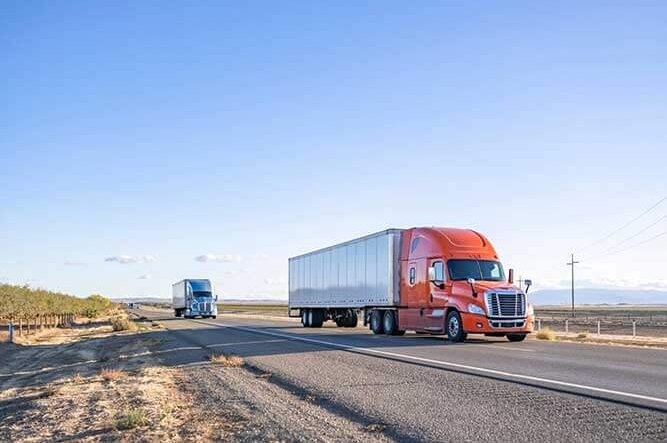OTR Trucking: What It Is & Job Requirements

What are you waiting for?
Make more money starting now.
About 3.5 million truck drivers operate in the U.S. today, moving 73% of all the freight in America. Among them are local drivers, regional drivers, hotshot truckers, and over-the-road (OTR) truck drivers.
OTR truck drivers haul the goods that make modern life possible — heavy machinery, vehicles, and even the food we eat. Long-haul trucking is an essential job, but it’s also challenging. So if you’re thinking about a career in OTR trucking, make sure you know the pros and cons of the occupation.
We’ll outline what OTR truck drivers do, how this type of driving compares to regional and local trucking, and share some pros and cons of the job.
What is over-the-road trucking (OTR)?
Over-the-road trucking involves hauling freight over long distances, often across state lines and even national borders. An over-the-road trucker might spend 3-4 weeks on the road at a time, sleeping in either the truck’s cabin or at hotels and motels along the way.
It’s common to see two-person OTR teams on the road instead of just solo drivers. With someone else driving the route, the team can operate in shifts, ensuring they stay compliant with driving regulations without losing time on the road.
Many truck drivers get their start as an OTR driver. But plenty of seasoned drivers pursue an OTR career because there is always a high demand for OTR drivers, and they can often earn higher salaries.
OTR vs. regional and local trucking
Llet’s look at how OTR, regional, and local driving compares.
Regional trucking
Regional truck drivers only move goods in a specific part of the country, like within a state, or within the Northeast, the Midwest, or the Southwest. These drivers may also move from region to region to follow opportunities during busy shipping seasons.
The average annual salary for regional driving is usually less than OTR trucking salaries, but regional drivers also get to spend time with their families.
Local trucking
Local trucking is short-range trucking, and it generally pays less than regional and OTR driving. In this type of job, you’re usually home by the end of the workday.
You might deliver goods from a factory or warehouse to stores or from one business to another within about a 200-mile square radius. Local truckers don’t always cross state lines, but they might if it’s necessary to complete their route.
In this type of job, you’d be on small local roads more often than you would with a regional or OTR position. You might also drive a smaller truck, and you might make multiple stops to complete your route.
Job requirements
To become a long-haul trucker, you’ll need a commercial driver’s license (CDL).
There are three classes of CDL:
- Class A CDL (most common): Required to operate vehicles with a gross combined weight rating (GCWR) of 26,001 pounds or more (tractor-trailers, tankers, livestock carriers, and flatbeds).
- Class B CDL: Required to operate a single vehicle that isn’t hitched to a trailer with a combined weight greater than 26,001 pounds (tourist buses, school buses, heavy delivery trucks).
- Class C: Required to operate a single vehicle with a combined weight greater than 26,001 pounds or a vehicle towing another vehicle that weighs less than 10,000 pounds (double trailers, tank trucks, and vehicles that transport 16 or more passengers).
If you intend to transport hazardous materials as part of your OTR job, you’ll need a special CDL HAZMAT endorsement, which requires drivers to pass a CDL HAZMAT test.
The licensing process varies by state, but every state requires you to complete a written test and a practical driving test. The best place to start is to obtain a CDL handbook from your state. You can study this and take the CDL test on your own if you’d like. Many drivers prefer to take a CDL course at a trucking school to add some structure to the learning process.
OTR trucker salary ranges
According to the U.S. Bureau of Labor Statistics, the 2023 median pay for heavy and tractor-trailer truck drivers was $54,320 per year or $26.12 per hour. But trucker salaries vary to a great degree.
According to GlassDoor, the median OTR truck driver salary is around $99,000.
Pros of over-the-road trucking
Over-the-road trucking can be challenging. It means being on the road for long periods, so many OTR drivers consider it a lifestyle. But the perks may offset the inconvenience of driving longer distances.
1. Over-the-road truck driving jobs offer flexibility and freedom.
The nature of the job is independence — the freedom to set your own schedule, take only the loads you want, and make your own decisions.
2. The money can be good.
The pay for long trips can be appealing, since most OTR truckers are paid a per-mile rate for long-distance driving. Generally speaking, the average salary for long-haul driving is about 20% percent higher than short-haul salaries.
3. It may be easier to coordinate.
Whereas local counterparts might have to spend a lot of time stacking jobs and coordinating pickup and delivery, long-haul trucking is just one trip.
4. Trucking jobs are plentiful.
Even in tough economic times, the demand for goods creates job opportunities for OTR drivers.
Cons of OTR trucking
Here are some cons of being an OTR truck driver.
1. Compliance challenges.
When you’re driving extensive distances, you have to keep a close eye on your hours of service (HOS). You should plan on getting an electronic logging device (ELD) app to make sure you comply with federal HOS requirements.
Most long-distance truckers develop a habit of updating their logs every day, because it’s the best way to ensure ongoing compliance. And don’t forget the importance of a clean driving record!
3. It can be hard on your health.
Local drivers might get in and out of their trucks several times a day as they go from one location to another. But long-distance driving usually amounts to less physical activity — not to mention a lack of healthy, home-cooked meals.
This job can be challenging for drivers who already have health conditions like diabetes or high cholesterol, so regular wellness checks are important in this line of work.
4. Time away from family can be stressful.
As we mentioned, over-the-road trucking is a lifestyle. It means being away from your family for extended periods. This can be a challenge for some new drivers, but it’s something most truckers get used to, as it’s part of the job.
Find your next route.
Check out the Truckstop Load Board to find your next route, whether you’re looking for OTR work, or local and regional jobs. Find out why the trucking industry relies on Truckstop to make every job easier.to wait. Check out the Truckstop Load Board to find your next OTR route.
Get helpful content delivered to your inbox.
Sign up today.
Find high-quality loads fast, get higher rates on every haul, and access tools that make your job easier at every turn.






